Ajay K Agrawal
Robert F. Barfield Endowed Professor, Department of Mechanical Engineering
https://scholar.google.com/citations?hl=en&user=IogAX3cAAAAJ
https://Agrawal.people.ua.edu
Students:
This lab is dedicated to advance combustion research for household and industrial applications. Lab provides capabilities to study combustion of solid wood, and liquid and gaseous fuels in multiple ventilated hoods. Typically, low-pressure experiments are performed within the test cell, but an external control room with observation windows is available for remote operation with the detonation tube.
Wood Heaters are a common heating option in remote and suburban areas where wood is easily available. Although wood is a renewable fuel, pollutants produced from residential wood heaters pose greater environmental and health risks than generally acknowledged. Residential wood smoke causes many counties in the U.S. to exceed the EPA’s health-based national ambient air quality standards (NAAQS) for fine particles.
Our research on ultra-clean, highly efficient wood heaters seeks to (i) reduce soot emissions by at least 25-50% relative to the EPA 2020 emissions limits, (ii) increase average thermal efficiency by at least 5-15% over the baseline design, (iii) generate electricity to operate the wood heater independent of the grid power via thermoelectric generator (TEG) integration, (iv) automate wood heater operation using robust sensors and feedback control, and (v) secure real-time performance monitoring, and data driven autonomous control through a Smart App. Ultimate goal is to develop a direct vent system, a feature not available in existing wood heater designs.

Our wood heater design is based on rich-quench-lean (RQL) concept pioneered by the aircraft industry. Forced convection is used to supply combustion air by two intake fans, one at the primary zone inlet and another at the quench zone inlet. Gasification products from the primary zone enter the quench zone where preheated quench air is introduced. The premixed mixture combusts in the secondary zone to produce a dominantly blue flame with low emissions. The wood burning rate can be controlled by varying the total airflow rate and hence the heat release rate (HRR) to match the actual heating load demand of the residence in real-time. The combustor is placed inside a heat transfer box for efficient heat transfer to the ambient.
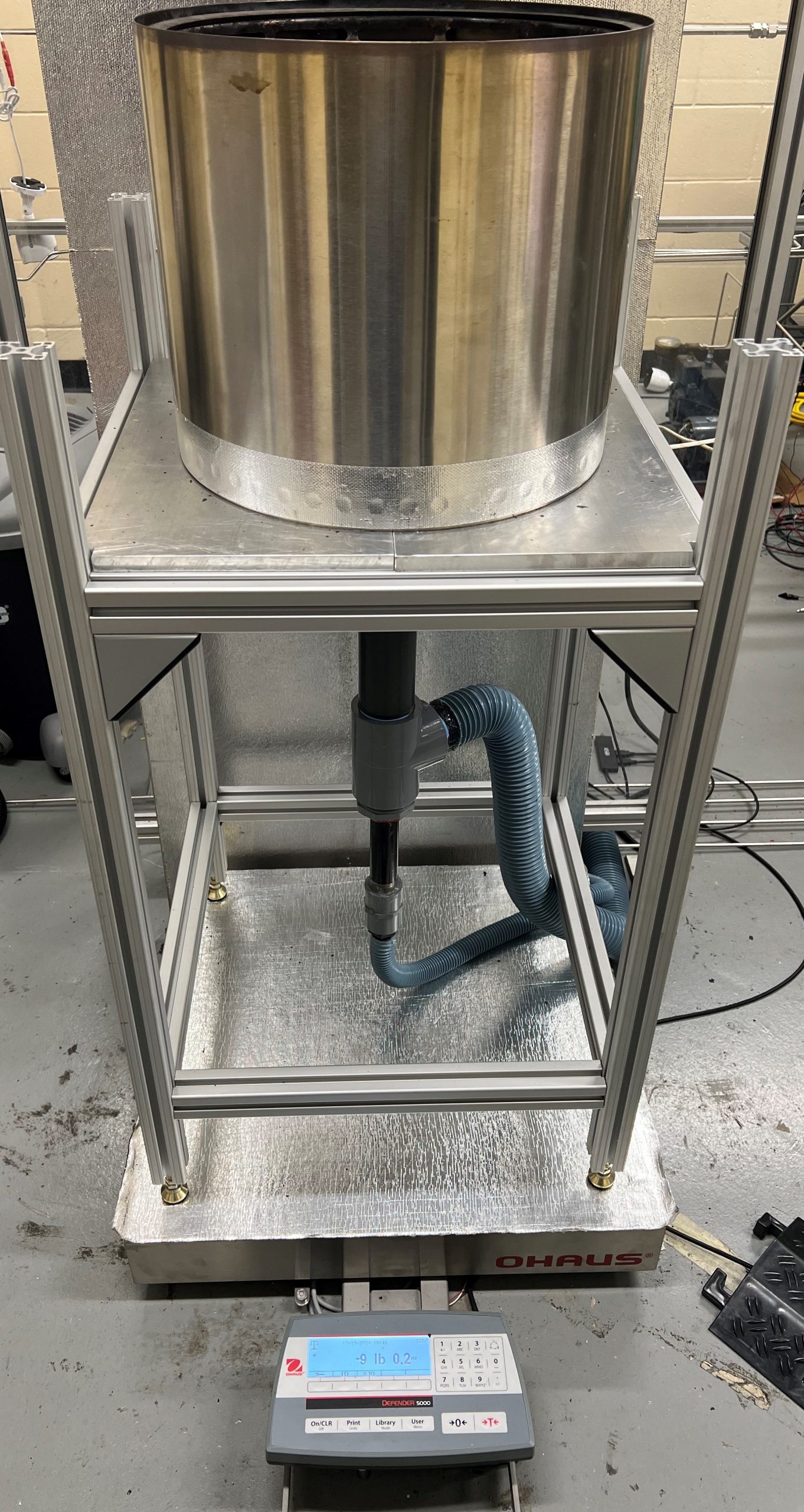
Fuel Atomization is critical to achieve, or approach lean premixed combustion of liquid fuels, especially in case of highly viscous alternative biofuels and/or waste fuels. This lab was the first to implement the Flow Blurring (FB) concept for liquid fuel atomization and combustion in 2008. Conventional injectors rely upon shear layer instabilities to atomize the fuel using kinetic energy either of the fuel or an atomizing gas.
Flow blurring (FB) injector is a twin-fluid atomization concept to produce a fine spray at the injector exit, regardless of the physical properties of the fuel. Fuel is atomized by pressurized gas bubbles that are formed and distributed across the liquid jet immediately before it exits the injector. Bubbles expand to shatter the liquid fuel in a uniform manner. This form of fuel atomization is stable and much more efficient compared to air-blast, air-assist, or other kinetic-energy based techniques.
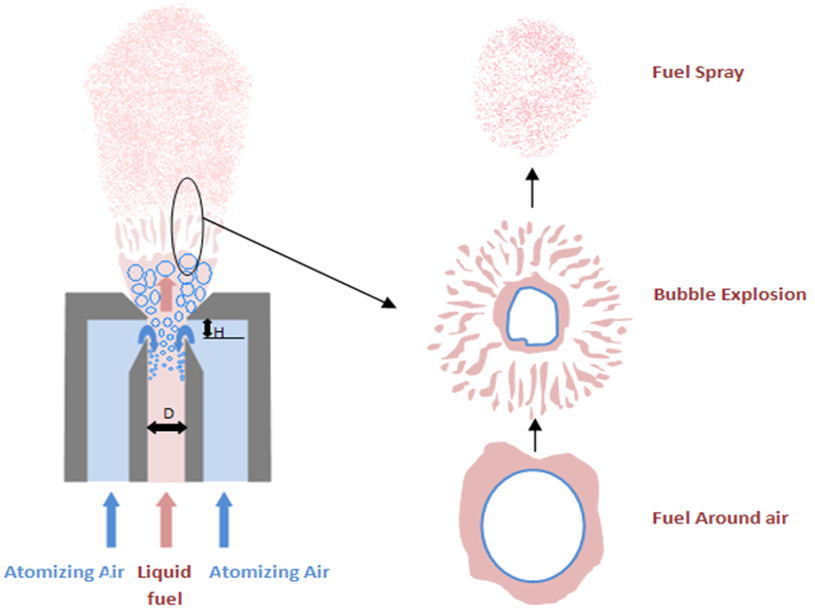 Illustration of FB atomization
Illustration of FB atomization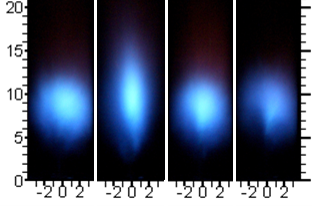
Clean blue spray flames (left to right) of diesel, straight vegetable oil (VO), 70/30 diesel-VO blend, and biodiesel produced by FB atomization.
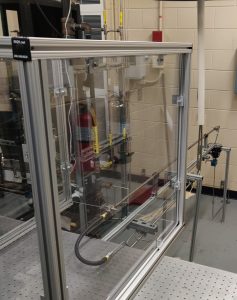
Detonation experiments to study shock propagation and related phenomena are performed in a small tube filled with reactants of known composition. An automation system comprising compressed gas cylinders (methane, nitrogen, oxygen, etc.) and pressure regulators produces premixed reactants that are stored in a cylinder, which then supplies reactants to the detonation tube.
An automotive spark plug at the inlet and a burst disk at the exit are used to produce the detonation wave at well controlled initial conditions. This system has been used to analyze response of pressure transducers and to study detonation wave using high-speed schlieren imaging.
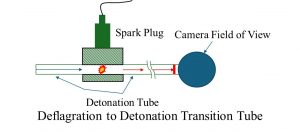
 Color schlieren image of normal compression shock with associated flow structures, 50 ns pulse duration
Color schlieren image of normal compression shock with associated flow structures, 50 ns pulse duration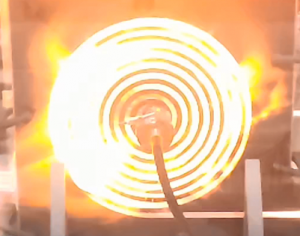 Shock propagation inside a spiral
Shock propagation inside a spiralSample Presentation(s):
Related Publications:
- A. McClinton, and A.K. Agrawal, Wood stove with forced convection for rich quench lean combustion, Central States Sections Meeting, Paper 1C06, May 2024, Cleveland, OH.
- A. Ghorashi, A.K. Agrawal, B. Khandelwal, Development of high efficiency heat extraction system to be used with wood fired heating systems Central States Sections Meeting, Paper 2A05, May 2024, Cleveland, OH.
- Agrawal, A.K., Atomization and Combustion, Chapter 12, in Renewable Fuels: Sources, Conversion, and Utilization, eds: Jacqueline O’Connor, Bobby Noble, and Tim Lieuwen, Cambridge University Press, 2022.
- Panchasara, H., Kolhe, P.S., and Agrawal, A.K., 2020, Spray Flame Characteristics of Bio-Derived Fuels in a Simulated Gas Turbine Burner, ASME Journal of Engineering for Gas Turbines and Power, 142(8).
- Niguse, Y. and Agrawal, A.K., 2018, “Twin-fluid atomized spray combustion of straight vegetable oil at elevated pressures,” ASME Journal of Engineering for Gas Turbines and Power, 140(11), p.111504.
- Niguse, Y., and Agrawal, A.K., 2016, “Low-Emission, liquid fuel combustion system for conventional and alternative fuels developed by the scaling analysis,” Journal of Engineering for Gas Turbines and Power, 138(4), 041502.
- Jiang, L., and Agrawal, A.K., 2015, “Spray Features in the Near Field of a Flow-Blurring Injector Investigated by High-Speed Visualization and Time-Resolved PIV,” Experiments in Fluids, 56(5), p. 103.
- Agrawal, A.K., 2015, “Low-Emission, Fuel-Flexible Combustion of Liquid Biofuels,” Book Chapter in Novel Combustion Concepts for Sustainable Energy Development, Gupta, Agrawal, Pandey (eds), Springer.
- Jiang, L., and Agrawal, A.K., 2015, “Investigation of Glycerol Atomization in the Near-Field of a Flow-Blurring Injector using Time-Resolved PIV and High-Speed Visualization,” Flow, Turbulence, and Combustion, vol. 94, pp. 323-337.
- Jiang, L., and Agrawal, A.K., 2014, “Combustion of Straight Glycerol With/Without Methane Using a Fuel-Flexible, Low-Emissions Burner,” Fuel, vol. 136, pp 177-184.
- Jiang, L., Agrawal, A.K., and Taylor, R.P., 2014, “Clean Combustion of Different Liquid Fuels using a Novel Fuel Injector,” Experimental Thermal and Fluid Science, vol. 57, 275-284.
- Simmons, B., and Agrawal, A.K, 2012, “Flow Blurring Atomization for Low-Emission Combustion of Liquid Biofuels,” Combustion Science and Technology, vol. 184, 660-675.
- Simmons, B., and Agrawal, A.K., 2010, “Spray Characteristics of a Flow-Blurring Atomizer,” Atomization and Spray, vol. 20, 821-835.
- Agrawal, A.K., 2009, “Innovative Combustion and Emissions Reduction Techniques,” in Combustion Science and Technology: Recent Advances, (eds.) A.K. Agarwal, A. Kushari, S.K. Aggarwal, and A.K. Runchal, pp. 1-36, Narosa Publishing House, New Delhi.
- Panchasara, H., Sequera, D., Schreiber, W., and Agrawal, A.K., 2009, “Emission Reductions in Diesel and Kerosene Flames using a Novel Fuel Injector,” Journal of Propulsion and Power, vol. 25, no. 4, pp 984-986.
- Panchasara, H., Simmons, B., Agrawal, A.K., Spear, S., and Daly, D., 2009, “Combustion Performance of Bio-Diesel and Diesel-Vegetable Oil Blends in a Simulated Gas Turbine Burner,” Journal of Engineering for Gas Turbines and Power, vol. 131, 031503, 11p.